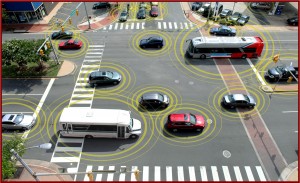
V2V allows vehicles to send and receive from each other information such as location, speed and direction of travel. V2I shares information about traffic signal phase, road attributes and surface conditions. Each could mitigate traffic collisions and congestion. Together, they can be integrated with active safety features, such as forward collision warning and blind zone alert, already in production.
The U.S. Department of Transportation is starting the largest road test or vehicles with crash avoidance technology today in Ann Arbor, Michigan. About 3,000 cars, trucks and buses equipped with “connected” Wi-Fi technology that allows vehicles and infrastructure devices to “talk” to each other. The goal is to see if crashes could be avoided and traffic flow improved during the next year. In Europe, such technologies are also under study.
Conducted by University of Michigan’s Transportation Research Institute or UMTRI, the road test, uses mostly vehicles supplied by automakers and suppliers. They are fitted with vehicle-to-vehicle (V2V) and vehicle-to-infrastructure (V2I) communication devices that will gather data about system operability and its effectiveness at reducing crashes. The data will also proved precise information about vehicle location and driver behavior, which raises thorny privacy and legal issues.
According to DOT’s National Highway Traffic Safety Administration, V2V safety technology could help drivers avoid or reduce the severity of four out of five “unimpaired” vehicle crashes. To accomplish this, vehicles will send electronic data messages, receive messages from other equipped vehicles, and translate the data into a warning to the driver during specific hazardous traffic scenarios. Such hazards include an impending collision at a blind intersection, a vehicle changing lanes in another vehicle’s blind spot, or a rear collision with a vehicle stopped ahead, among others.
“NHTSA will use the valuable data from the ‘model deployment’ as it decides if and when these connected vehicle safety technologies should be incorporated into the fleet,” said NHTSA Administrator David Strickland, who appeared to be doing his job today instead promoting the Obama Administration.
According to the Texas Transportation Institute, American drivers spent 4.8 billion hours stuck in traffic in 2010—the equivalent of nearly one full work week for every traveler on U.S. roadways each year.
The information collected from the tests, along with other key research projects, will be used by NHTSA to determine by 2013 whether to proceed with additional activities involving connected vehicle technology, including possible rulemaking. For more information on DOT’s connected vehicle research, visit www.safercar.gov/connectedvehicles.

